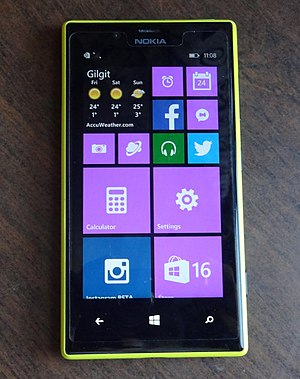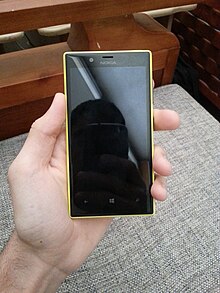
The Nokia Lumia 800, which was codenamed 'Sea Ray', is a smartphone that was launched by Nokia on October 26, 2011, at the Nokia World 2011 event. Initially, it operated on Snapdragon S2 processor and Windows Phone 7.5 "Mango" and was the first device manufactured by Nokia to run on the Windows Phone operating system. This marked a significant shift for the company from using Symbian for their smartphones. Upon its original release in November 2011 in Europe, it was Nokia's flagship product and was hence a crucial product for their mobile phone business.
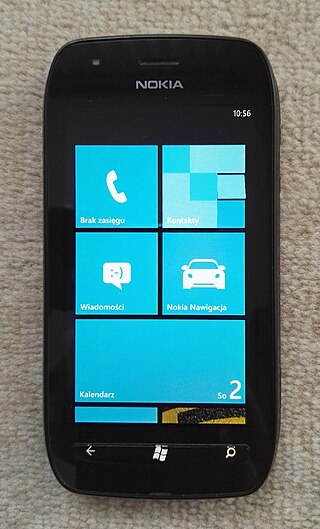
Nokia Lumia 710 is a Windows Phone 7 smartphone. Its release is part of a change in company's direction which has resulted in a shift from Symbian platform towards Windows Phone for smartphones. While the Nokia Lumia 800 and Lumia 900 target the high-end of the smartphone marketplace, the Lumia 610 and Lumia 710 are aimed at the mid-range price point. This generation of Lumia phones ship with Windows Phone 7.5 "Mango". Its design is almost the same as the Symbian Nokia 603, announced just over a week earlier.
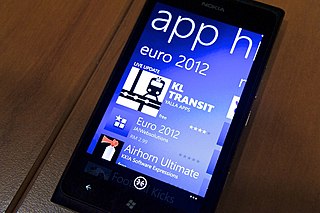
The Nokia Lumia 900 is a Windows Phone-powered smartphone, first unveiled on January 9, 2012, by Nokia at Consumer Electronics Show 2012, where it won the Best Smartphone award in January 2012. The phone has 4G LTE support and was released in April 2012. The Lumia 900 was the flagship smartphone of the Lumia range until the release of its successor, the Lumia 920.

Microsoft Lumia is a discontinued line of mobile devices that was originally designed and marketed by Nokia and later by Microsoft Mobile. Introduced in November 2011, the line was the result of a long-term partnership between Nokia and Microsoft—as such, Lumia smartphones run on Microsoft software, the Windows Phone operating system; and later the newer Windows 10 Mobile. The Lumia name is derived from the partitive plural form of the Finnish word lumi, meaning "snow".
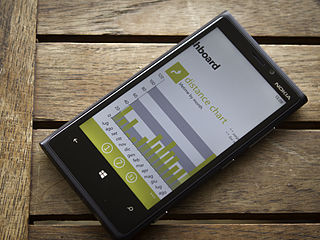
Nokia Lumia 920 is a smartphone developed by Nokia that runs the Windows Phone 8 operating system. It was announced on September 5, 2012, and was first released on November 2, 2012. It has a 1.5 GHz dual-core Qualcomm Krait CPU and a 4.5" IPS TFT LCD display, as well as a high-sensitivity capacitive touchscreen that can be used with gloves and fingernails; the display is covered by curved Gorilla Glass and has a 9 ms response time. The phone features an 8.7-megapixel PureView camera with OIS; it was the first smartphone camera to implement that technology, as well as to support Qi inductive charging. The phone comes with 32 GB of internal storage, but has no expandable storage.

The Nokia Lumia 820 is a smartphone designed, developed and marketed by Nokia. It is the successor to the Lumia 800 and is one of the first Nokia phones to implement Windows Phone 8 alongside the Nokia Lumia 920. Although sharing a similar appearance with the Lumia 800, the Lumia 820 is a major overhaul over its predecessor, sporting a 4.3 inches (110 mm) diagonal OLED display with scratch resistant glass, though lacking Gorilla Glass protection, 1.5 GHz dual-core processor, and an 8.7-megapixel camera. The phone will come with LTE connectivity and a wireless-charging option. The 820 is the first Nokia Windows Phone OS based smartphone to embed a microSD card slot.
The Nokia Lumia 810 is a Windows Phone smartphone made by Nokia exclusively for wireless carrier T-Mobile US. It was announced on October 8, 2012. The device runs the then-new Windows Phone 8 operating system and features a 4.3-inch AMOLED WVGA ClearBlack display, an 8-megapixel rear-facing camera, a 1.5 GHz Snapdragon processor, exchangeable shells and supports Qi inductive charging when equipped with a specific shell. It supports T-Mobile's 4G network.
The Nokia Lumia 822 is a smartphone running Windows Phone 8 announced on 29 October 2012. It is exclusively available for Verizon customers. The device is a variant of Nokia Lumia 820. The Lumia 822 supports Qi standard induction charging and LTE connectivity.

The Nokia Lumia 620 is an entry-level smartphone designed, developed and marketed by Nokia. It is the successor to the Lumia 610, and is one of the first Nokia phones to implement Windows Phone 8 alongside the Nokia Lumia 920 and Nokia Lumia 820. Although sharing a similar name with the Lumia 610, the Lumia 620 is a major overhaul over its predecessor, employing a 1.0 GHz dual-core processor. It also has exchangeable back covers which come in black, white, magenta, yellow, cyan etc.

The Nokia Lumia 520 is an entry-level Windows Phone 8 smartphone announced by Nokia at the 2013 Mobile World Congress.

Lumia imaging apps are imaging applications by Microsoft Mobile and formerly by Nokia for Lumia devices built on the technology of Scalado. The Lumia imaging applications were notably all branded with "Nokia" in front of their names, but after Microsoft acquired Nokia's devices and services business the Nokia branding was superseded with "Lumia", and often updates included nothing but name changes, but for the Lumia Camera this included a new wide range of feature additions. Most of the imaging applications are developed by the Microsoft Lund division. As part of the release of Windows 10 Mobile and the integration of Lumia imaging features into the Windows Camera and Microsoft Photos applications some of these applications stopped working in October 2015.

The Nokia Lumia 2520 is a Windows RT tablet computer originally developed by Nokia. It is Nokia's first and only Windows-based tablet, and the company's first tablet since its Nokia Internet Tablet line. Sharing its design and marketed with the Nokia Lumia series of Windows Phone products, the device incorporates a quad-core Snapdragon 800 chip with 4G LTE support, along with a 10.1-inch (26 cm) 1080p display and an optional "Power Keyboard" dock adding additional battery capacity, USB ports, and a physical hardware keyboard. Following a period of speculation and leaks, the Lumia 2520 was officially unveiled on 22 October 2013, and released in North America on 21 November 2013.

The Nokia Lumia 1520 was a flagship Windows Phone phablet smartphone designed and produced by Finnish telecommunications manufacturer Nokia in partnership with American software manufacturer Microsoft. The device was first announced at the Nokia World event on 22 October 2013 in Abu Dhabi, alongside its mid-range phablet stablemate the Nokia Lumia 1320 and Nokia's 10.1 inch Windows RT tablet the Nokia Lumia 2520. Until its discontinuation in the United States on 7 April 2015 the phone served as the flagship device for Nokia's Lumia Series and Microsoft's mobile effort. On 6 October 2015 Microsoft officially announced its flagship phablet successor, the Microsoft Lumia 950 XL, with availability sometime in November 2015.
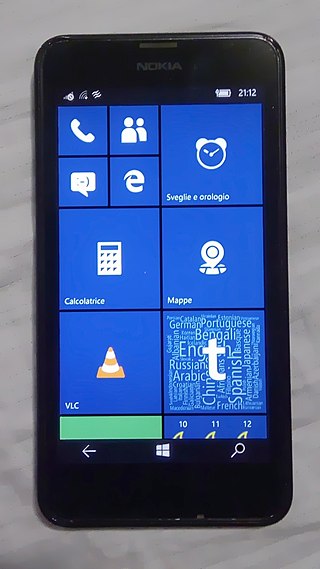
The Nokia Lumia 630 is a smartphone developed by Microsoft Mobile that runs Microsoft's Windows Phone 8.1 operating system. It was announced on 2 April 2014, at Microsoft Build 2014 and scheduled to be released in July 2014. It has a Qualcomm Snapdragon 400 SoC with a quad-core processor and Adreno 305 GPU. Additionally, it has a 4.5-inch display and a 5 MP camera. The Lumia 635 is similar but 4G-compatible, lacks a dual-SIM version and comes in a different finish, while the Lumia 636 and 638 are identical, but come with 1 GB of RAM and are currently available only in China and India respectively.
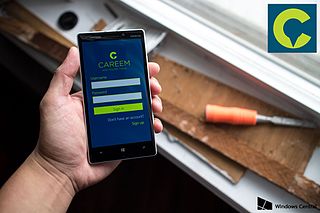
The Nokia Lumia Icon is a high-end smartphone developed by Nokia that runs Microsoft's Windows Phone 8 operating system. It was announced on February 12, 2014, and released on Verizon Wireless in the United States on February 20, 2014. It is currently exclusive to Verizon and the U.S. market; its international counterpart is the Nokia Lumia 930.
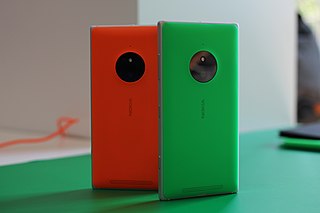
The Nokia Lumia 830 is a smartphone developed by Microsoft Mobile and branded as "Nokia" that runs Microsoft's Windows Phone 8.1 operating system. It was announced on September 4, 2014 at Internationale Funkausstellung Berlin and released in October 2014. It is a successor to the 2012 Nokia Lumia 820 and marketed as an "affordable flagship".
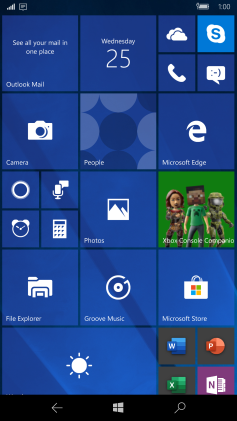
Windows 10 Mobile was a mobile operating system developed by Microsoft. First released in 2015, it is a successor to Windows Phone 8.1, but was marketed by Microsoft as being an edition of its PC operating system Windows 10.

The Microsoft Lumia 640 and Microsoft Lumia 640 XL are Windows Phone smartphones developed by Microsoft Mobile. Both phones were announced on March 2, 2015, and are the successors to the Nokia Lumia 630 series and the Lumia 1320, respectively. The phones are primarily aimed at developing markets, although they are also available in developed markets as lower-cost options compared to other phones in their classes. The two devices became available in the US and most other markets in June 2015.

Microsoft Lumia 950 is a smartphone developed by Microsoft, officially revealed on 6 October 2015 alongside the larger Lumia 950 XL. The phone was first released on AT&T in the United States on 17 November 2015, and subsequently made available on the Microsoft Store as well as in other countries.

The Microsoft Lumia 950 XL is a smartphone developed by Microsoft, officially revealed on October 6, 2015 and released on November 20, 2015 alongside the smaller Lumia 950. The Lumia 950 XL is the successor to the Nokia Lumia 1520 and is among the first phones to natively run Windows 10 Mobile. The phone is primarily aimed at users desiring a flagship device, in contrast to Microsoft's previous strategy of targeting developing markets with low-end hardware.
